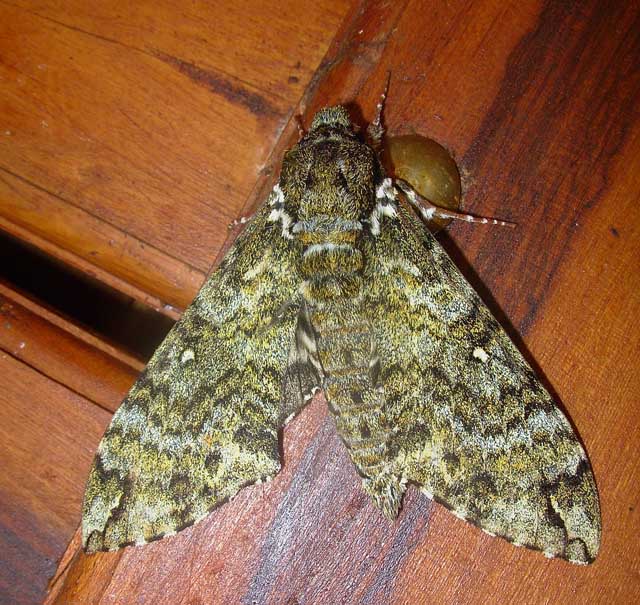Manduca lichenea
|
|
Updated as per the L.O.L.A. publication Hawkmoths of Argentina, More, Kitching and Cocucci, 2005, October 2007.
Updated as per CATE, October 18, 2011
Updated as per personal communication with Ezequiel Osvaldo Núñez Bustos
(Campo Ramon, Misiones, Argentina, September 26, 2010); May 14, 2012
Updated as per personal communication with Sergio D. Ríos Díaz in CATÁLOGO DE LOS SPHINGIDAE (INSECTA: LEPIDOPTERA) DEPOSITADOS EN
EL MUSEO NACIONAL DE HISTORIA NATURAL DEL PARAGUAY; sent to me in July 2014 by Sergio D. Ríos Díaz.
|
Manduca lichenea
(Bermeister, 1855)

Manduca lichenea, Campo Ramon, Misiones, Argentina,
September 26, 2010, courtesy of Ezequiel Osvaldo Núñez Bustos
This site has been created by Bill Oehlke.
Comments, suggestions and/or additional information are welcomed by Bill.
TAXONOMY:
Family: Sphingidae, Latreille, 1802
Subfamily: Sphinginae, Latreille, [1802]
Tribe: Sphingini, Latreille, 1802
Genus: Manduca Hubner, 1807 ...........
Species: lichenea (Bermeister, 1856)
|
DISTRIBUTION:
Manduca lichenea (wingspan: approx. 94mm, females larger than males) flies in
Brazil: Rio de Janeiro (specimen type locality).
It is reported from Minas Gerais to Rio Grande do Sul. Kitching and Cadiou, 2002,
indicate it is endemic to southeastern Brazil. Specimens from other areas are most likely Manduca schausi, but
this species might also fly in southern Paraguay: San Pedro; Guaira; and
possibly northern Argentina: Misiones (EB & (JH & CM, 2019)). CATE reports specimens taken in south eastern Brazil, including Sao Paulo,
Parana, Santa Catarina, Rio Grande do Sul. and northern
Argentina: Misiones; and Uruguay.
"For almost one century, M. lichenea comprised two species, M. schausi
(Clark, 1919) from middle to high elevation from Mexico to Bolivia, and M. lichenea
itself. The latter is a less robust with rounder appearance and greener when fresh. The
forewing green ground color turn to light brown quickly when exposed to wet condition." Jean Haxaire and Carlos Mielke
However, it is not reported for Argentina in the L.O.L.A. publication Hawkmoths of Argentina, More, Kitching and Cocucci, 2005;
nor is it reported in Uruguay by Msc Maria Gabriela Bentancur Viglione, Faculty of Sciences, Montevideo, Uruguay, who indicates a recently published
checklist (2010) will shortly be forthcoming, based on SHILAP publication: Lista de Sphingidae del Uruguay. I am not sure if DNA barcoding will
sort this out.
Ezequiel Bustos reports that DNA barcoding confirms its presence in Argentina.
FLIGHT TIMES:
Manduca lichenea adults fly in September in Argentina (EB).
ECLOSION:
Pupae probably wiggle to surface from subterranean chambers just prior to eclosion.
SCENTING AND MATING:
Females call in the males with a pheromone released from a gland at the tip of the abdomen.
EGGS, LARVAE, PUPAE:
Larvae feed on ??
Return to Sphingidae Index
Return to Sphingini Tribe
Use your browser "Back" button to return to the previous page.
Ezequiel Bustos image:
Colección de Lepidoptera Proyecto DNA Barcodes Lepidoptera Argentina
Museo Argentino de Ciencias Naturales ¨Bernandino Rivadavia¨ (MACN)
Av. Angel Gallardo 470 (1405)
Ciudad de Buenos Aires
Argentina
This page is brought to you by Bill Oehlke and the
WLSS. Pages are on space rented from Bizland. If you would like to become a "Patron of the Sphingidae Site", contact Bill.
Please send sightings/images to Bill. I will do my best to respond to requests for identification help.
Enjoy one of nature's wonderments: Live
Saturniidae (Giant Silkmoth) cocoons.
 | 
Show appreciation for this site by clicking on flashing butterfly to the left.
The link will take you to a page with links to many insect sites. |


